#futureofmobility
Explore tagged Tumblr posts
Text
#ElectricVehiclesIndia#EVRevolution#CleanEnergyIndia#GreenMobility#SustainableTransport#GoElectric#EVAdoption#FutureOfMobility#IndiaOnEVs#EVInfrastructure#EVCharging#EVPolicy#EVTransitionZeroEmissions#RenewableEnergyIndia
13 notes
·
View notes
Text

Mahindra BE 6 – The Future of SUVs! ⚡🚙A stylish electric SUV with powerful battery options, up to 683 km range, and fast charging (20-80% in 20 min). Features dual 12.3” screens, ADAS, and a bold design with C-shaped LED DRLs.
4 notes
·
View notes
Text
Top 4 Best Hoverboards For [2025]

Watch Now From Here :
🚀 Step into the Future of Gliding! 🚀 Discover the Top 4 Hoverboards of 2025 that blend speed, power, style, and fun for EVERY rider!
🔹 Hover-1 Chrome: Cruise urban streets with Bluetooth beats and adaptive modes (6MPH, 6-mile range)! 🔹 EPIKGO Classic: Conquer mountains, gravel, and mud with dual 400W motors and LG battery power! 🔹 Gyroor G13: Light up the night with dazzling LEDs and a roaring 500W motor—perfect for kids and adults! 🔹 SIMATE: Unite the whole family with colorful lights, Bluetooth speakers, and endless smiles!
#Hoverboard2025#FutureOfMobility#Hover1Chrome#EpikgoAdventure#GyroorG13#SimateFun#BluetoothGlide#AllTerrainRider#LEDLightsMagic#FamilyRides#TechMeetsThrill#UpgradeYourRide#tech2025#tech2024
2 notes
·
View notes
Text
Ford's Smart Traffic Light System😮😄
#desiviralrecap#SmartTechnology#Innovation#TechForGood#FutureOfMobility#SmartCities#FordInnovation#SmartTrafficLights#AutomotiveTech#FordFuture#ConnectedVehicles#EcoInnovation#GreenTech#SustainableTransportation#CleanMobility#SmartCitySolutions#TechNews#FutureIsNow#SmartSystems#TrafficTech#InnovationNation
1 note
·
View note
Text
#ElectricVehiclesIndia#EVRevolution#CleanEnergyIndia#GreenMobility#SustainableTransport#GoElectric#EVAdoption#FutureOfMobility#IndiaOnEVs#EVInfrastructure#EVCharging#EVPolicy#EVTransitionZeroEmissions#RenewableEnergyIndia
2 notes
·
View notes
Text
Audi Activesphere Concept: The Future of Premium Mobility
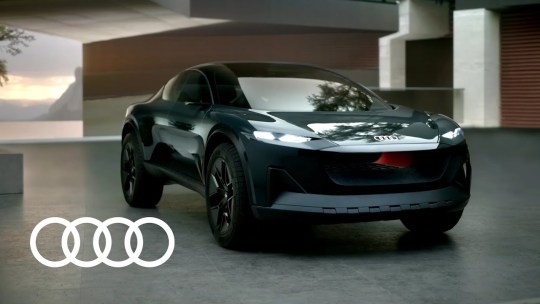
View On WordPress
#Audi#AudiActivesphereConcept#ConceptCar#conceptvehicle#electric vehicles#electriccar#Future#futureofmobility#LuxuryCar#Technology
4 notes
·
View notes
Text
#Hyundai Motor#IONIQ6N#ElectricPerformance#EVnews#EVupdate#FutureOfMobility#ElectricVehicles#AutoEVTimes#GreenMobility#HighPerformanceEV#LimitedEditionEV#SustainableDriving#electricvehiclesnews#evtimes#autoevtimes#evbusines
0 notes
Text
#ElectricMobility#UrbanLogistics#ECargoBikes#EVAdoption#SustainableTransport#FutureOfMobility#TimesTech#GreenLogistics#EVChallenges#electronicsnews#technologynews
0 notes
Text
𝐀𝐮𝐭𝐨𝐦𝐨𝐭𝐢𝐯𝐞 𝐃𝐨𝐨𝐫 𝐏𝐚𝐧𝐞𝐥 𝐌𝐚𝐫𝐤𝐞𝐭: 𝐃𝐫𝐢𝐯𝐢𝐧𝐠 𝐂𝐨𝐦𝐟𝐨𝐫𝐭, 𝐒𝐭𝐲𝐥𝐞, 𝐚𝐧𝐝 𝐒𝐚𝐟𝐞𝐭𝐲 𝐢𝐧 𝐌𝐨𝐝𝐞𝐫𝐧 𝐕𝐞𝐡𝐢𝐜𝐥𝐞𝐬
𝐆𝐞𝐭 𝐒𝐚𝐦𝐩𝐥𝐞 𝐏𝐃𝐅 𝐆𝐮𝐢𝐝𝐞: - https://www.theinsightpartners.com/sample/TIPRE00004972
Automotive door panels, once seen as basic structural components, have evolved into sophisticated elements that contribute significantly to vehicle comfort, aesthetics, safety, and functionality. As the automotive industry embraces electrification, light weighting, and interior customization, the automotive door panel market is undergoing a dynamic transformation.

#AutomotiveDoorPanel#VehicleInteriors#SmartCarInteriors#LightweightMaterials#AutoInteriorDesign#ElectricVehicleComponents#AutomotiveInnovation#SustainableAutomotive#AutomotiveManufacturing#CarInteriorTrends#AutoPartsMarket#AutomotiveOEM#InteriorTrimSolutions#FutureOfMobility#SmartCarTechnology#barbie
0 notes
Text
MakeTime Philosophy: How Future-First Thinking Drives Innovation, Purpose & Progress
What Is the MakeTime Philosophy?
The MakeTime philosophy is more than a productivity hack—it's a future-first mindset that empowers individuals to lead, create, and innovate before the world is ready.

In every generation, there are two kinds of people: 👉 Those who wait. 👉 And those who make time.
MakeTime is about building what's missing, not what's trending. It’s about acting with intention, anticipating change, and crafting tomorrow today.
A Quiet Revolution in Innovation Mindset
MakeTime isn't a slogan—it’s a quiet rebellion against waiting. It’s the decision to act without external validation, to build before it's demanded, and to lead when others hesitate.
This proactive mindset for innovators and entrepreneurs is guided by one truth:
“Progress doesn’t always knock—you have to build the door.”
History Favors the Visionaries
Throughout history, progress was driven by those who didn’t wait for permission:
When the world believed the Earth was flat, someone set sail.
When flight seemed impossible, someone designed wings.
When space was unknown, someone listened to the stars.
These were future-first thinkers. They didn’t wait—they made time.
What It Truly Means to “Make Time”
To make time means to:
✅ Choose purpose over procrastination ✅ Act on ideas before they’re in demand ✅ Build value before recognition arrives ✅ Prioritize creation over imitation
It’s not about being first to finish—it’s about being first to believe, first to move, and first to create impact.
Ask Yourself:
What can I build before the world asks for it?
What can I improve before it becomes a crisis?
What can I give without expecting applause?
The MakeTime philosophy isn’t reserved for inventors. It’s for teachers, parents, entrepreneurs, and everyday leaders.
The Future Is Built—Not Found
We often think the future is something we’ll reach. But the truth is:
The future is a product of what we do today.
Future-first thinking is not about waiting for what's next—it's about creating it now.
Those who make time don’t chase the future. They lead it.
Innovation Is a Daily Mindset
True innovation isn’t scheduled. It doesn’t appear on a planner.
It happens when we:
Begin before it's comfortable
Build before it’s proven
Create without consensus
This is what it means to have a future-first innovation mindset—one driven by courage and anticipation.
MakeTime Is a Movement, Not Just a Moment
You don’t need to invent a machine to make time.
A parent makes time by choosing better for their child.
A teacher makes time by igniting curiosity.
A community makes time by planning for generations.
Every act of intentional innovation makes time.
How aerpace Applies the MakeTime Philosophy
At aerpace, we didn’t wait for the future—we started building it.
While others focused on optimizing the present, we asked:
“What’s next—and how do we lead it?”
From aerWing (flying mobility) to aerDock, aerCargo, and aerVolt (solar-powered systems), we designed an ecosystem rooted in the MakeTime philosophy.
Our Vision:
Mobility as a right, not a luxury
Clean energy by default, not exception
Removing distance as a barrier to opportunity
We’re not just building for today. We’re reimagining the entire transportation ecosystem for tomorrow.
Join the MakeTime Movement
If you're tired of waiting for change—become it.
✅ Build what’s missing ✅ Move with intention ✅ Begin before it’s expected
At aerpace, we’ve been making time for the future—since yesterday. Now it’s your turn.
🌍 The future isn’t a place we go—it’s a place we create. Will you MakeTime?
#MakeTime#futurefirst#visionarythinking#mindsetforinnovation#proactiveleadership#aerpace#futureofmobility#cleantechnology#sustainability#buildthefuture#innovationmindset#leadwithpurpose#thinkahead#greentechnology#technologyblog#mobilitysolutions#inspirationalphilosophy#forwardthinking#tumblertechblog#aerpaceinnovation
1 note
·
View note
Text
Internal Combustion Engine
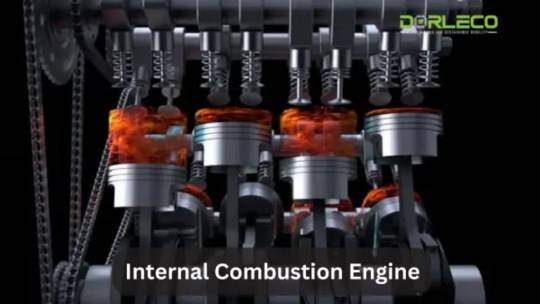
Introduction
For than a century, internal combustion engine (ICEs) have served as the foundation of contemporary transportation. More than 250 million vehicles in the US are powered by internal combustion engines (ICEs), which are renowned for their durability, fuel economy, and mechanical dependability. Globally, internal combustion engines (ICEs) have transformed transportation and power generation, changing everything from freight trucks to industrial equipment, and from small cars to airplanes. However, in the era of resource depletion, climate change, and carbon-neutral policies, ICEs are increasingly being scrutinized. The increasing popularity of electric vehicles (EVs) and sustainable fuels is putting the traditional internal combustion engine at a turning point. This blog discusses ICE classifications, components, operating principles, benefits, drawbacks, applications, and the evolving role of ICEs in a green energy future.
An internal combustion engine: what is it?
One kind of heat engine is an internal combustion engine, where fuel is burned inside a closed space. It converts the chemical energy of the fuel directly into mechanical energy, which drives machinery or propels an automobile ahead. Compared to external combustion engines (such as steam engines), internal combustion engines (ICEs) burn fuel inside the engine block, resulting in a more compact design and higher energy conversion efficiency.
Internal Combustion Engine Classifications
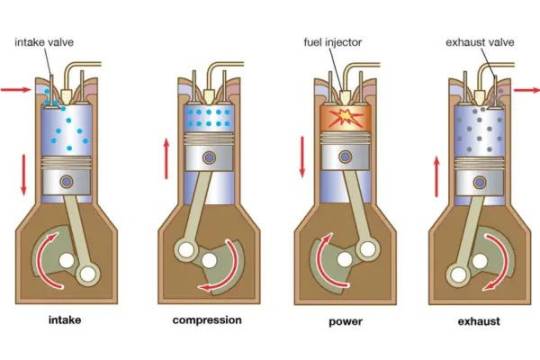
The ignition and combustion processes are the primary classification criteria for ICEs.
Engines with continuous combustion
These engines are constantly fed fuel and oxidizers, which create a steady flame. Among the examples are:
Gas-powered turbines
Jet Engine
They are known for their quick operations and consistent output, and they are mostly used in industrial and aviation environments.
Internal Combustion Engine Classifications
The ignition and combustion processes are the primary classification criteria for ICEs.
1. Engines with continuous combustion
These engines are constantly fed fuel and oxidizers, which create a steady flame. Among the examples are:
Gas-powered turbines
Jet Engine
They are renowned for their quick operations and consistent output, and they are mostly used in industrial and aviation environments.
2. Intermittent Combustion Engines (Reciprocating Engines)
Reciprocating engines, or intermittent combustion engines
These engines ignite a fuel and air mixture using timed cycles. There are two primary kinds:
In gasoline-powered spark-ignition engines, a spark plug is used to ignite the engine after compression.
Compression-ignition diesel engines start by heating compressed air and then injecting fuel.
Working Principle of ICEs
The basic concept is that a piston is moved by mechanical energy created when fuel burns in a cylinder. Most internal combustion engines use a four-stroke cycle, which includes the following steps, to accomplish this:
1. Stroke of Intake
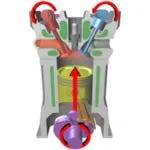
The air-fuel mixture (or just air in diesel engines) enters the combustion chamber at the beginning of the intake stroke as the piston falls and the intake valve opens.
2. Stroke by Compression
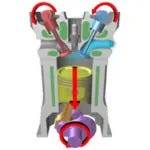
The piston then moves upward during the compression stroke, compressing the air-fuel mixture. Combustion is then started by a spark plug in gasoline engines or a fuel injector in diesel engines.
3. The Stroke of Power

Then, as the power stroke starts, the ignited air-fuel mixture pushes the piston downward, creating mechanical work that turns the crankshaft.
4. Stroke of Exhaustion

Consequently, during the exhaust stroke, the piston pushes the burned gasses out through the open exhaust valve. 🔁 With only one power stroke every two crankshaft revolutions, this cycle is continuously repeated in four-stroke ICEs.
Key Components of an Internal Combustion Engine
Understanding ICE anatomy helps grasp its function better:
ComponentFunctionCylinder HeadThe cylinder head contains the camshafts, injectors, spark plugs, and valves.Engine BlockContains pistons, crankshaft, and cylinders. Facilitates coolant flow.PistonA piston moves up and down within the cylinder to transmit force.CrankshaftConverts piston motion into rotary power.Combustion ChamberWhere fuel and air combine and ignite is the combustion chamber.
Internal Combustion Engine Benefits
Despite EVs’ growing popularity, ICEs still offer some important advantages: 🔧 Mature Technology: After decades of development, ICEs are incredibly reliable. 🛞 Its excellent power-to-weight ratio makes it ideal for mobile applications. 🏎️ Fast Start-Up: There is no waiting time, in contrast to steam engines. 💡 Fuel Types: Uses gasoline, diesel, natural gas, biodiesel, and ethanol. ⚙️ Compact Design: Easily integrated into a variety of vehicle sizes. 🔁 Reduced Maintenance: Routine upkeep is simple and available.
Disadvantages of Internal Combustion Engines
As stricter emission norms and environmental mandates take effect, the shortcomings of ICEs are becoming more apparent. 🌍 Environmental Impact: High emissions of CO₂ and NOx. 🧯Limited Fuel Sources: Reliant on fossil fuels. 💸 Fuel Price Fluctuations: Diesel and gasoline prices are unpredictable. 📢 Noise and Vibration: Greater than those of electric motors. 🔩 Energy Loss: Only around 25–30% of the fuel’s energy is converted into motion, with the remainder lost as heat.
Real-World Applications of ICEs
ICEs remain dominant in several sectors:
ApplicationEngine TypeExamplesAutomotiveGasoline & DieselCars, SUVs, MotorcyclesHeavy TransportDieselTrucks, Buses, LocomotivesMarineDiesel & Gas TurbinesCargo Ships, Patrol BoatsAviationJet Engines & TurbinesAirliners, DronesIndustrialStationary Gas EnginesGenerators, Pumps
Future of Internal Combustion Engines
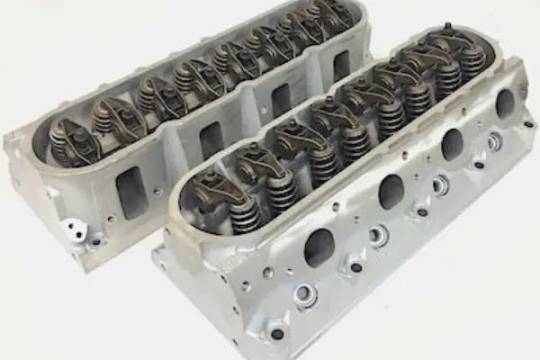
The ICE sector is developing quickly as net-zero targets get near. ICEs are becoming cleaner, more effective devices rather than going extinct.
1. Electrification and Hybridization
Electric motors are added to plug-in hybrids, full hybrids, and mild hybrids to improve overall efficiency, which increases mileage and lowers pollution.
2. Alternative Fuels Hydrogen: No emissions from the tailpipe.
In contrast to fossil fuels, renewable resources are used to produce biofuels. Designers create carbon-neutral synthetic fuels to be carbon neutral.
3. Engine Control Units (ECUs) Driven by AI
In order to increase economy, advanced ECUs use machine learning to optimize combustion settings.
4. Materials for Lightweight Engines
Furthermore, the use of carbon fiber, ceramics, and magnesium alloys not only improves performance but also significantly decreases weight.
5. Turbocharging and Engine Downsizing
Smaller displacement engines may use less gasoline and produce the same amount of power when equipped with turbochargers.
FAQs About Internal Combustion Engines❓
What is the main difference between spark-ignition and compression-ignition engines?
Spark-ignition engines (gasoline) use a spark plug for ignition, while compression-ignition engines (diesel) ignite fuel due to high-pressure heat.
Will there be a ban on internal combustion engines?
By 2035–2040, many nations, particularly the EU and California, intend to phase out ICE-only automobiles. Authorities might still permit clean-fuel ICEs and hybrids, however.
Are ICEs more efficient than electric motors?
No. Electric motors are up to 90% efficient, while most ICEs operate around 25–30% thermal efficiency. However, ICEs offer longer range and fueling flexibility.
Can internal combustion engines run on hydrogen?
Indeed. Although infrastructure and safety issues still exist, specially designed internal combustion engines (ICEs) can run on hydrogen fuel and emit water vapor as exhaust.
What is the future of ICE in India?
India is investing in E20 fuel, hybrid vehicles, and biofuels to extend ICE lifespan while gradually adopting EVs.
Conclusion
Internal combustion engines have powered the modern world for more than a century. From Henry Ford’s Model T to modern turbocharged hybrids, internal combustion engines (ICEs) represent the advancement of engineering. ICEs will continue to be useful even though the future is moving toward electric transportation, particularly in areas without EV infrastructure or in industries like aviation and maritime. Decarbonization, not demonization, is the true objective. ICEs can still help create a greener future through hybridization, cleaner fuels, and smarter systems. In the long run, the way ICE technology coexists with future mobility solutions will largely depend on our willingness to embrace innovation. Moreover, prioritizing efficiency and committing to sustainability will be essential as we collectively advance toward a cleaner and more sustainable future. 📢 Want to learn more about ICEs or electrification strategies? Visit dorleco.com or email us at [email protected] for VCU solutions, CAN displays, CAN Keypads ,Engineering Software Service provider and Engineering Staffing Services and more.
#DorleControls#InternalCombustionEngine#FutureOfMobility#SustainableEngineering#VCUSolutions#CANDashboard#EVSoftware#AutomotiveTechnology#HybridVehicles#GreenMobility#EngineeringServices#ICEFuture#Biofuels#Electrification#HydrogenFuel#CleanTech
0 notes
Text

Ather Energy is an Indian electric vehicle manufacturer known for its high-performance electric scooters like the Ather 450X. Ather focuses on innovation, connected tech, and clean mobility. Its scooters offer smart features, fast charging, and are designed for modern urban commuting.
To know more about Arther Energy, visit https://bikecarhub.com/ather-energy To know more about other bikes, visit www.bikecarhub.com
#bikecarhub#bike#AtherEnergy#ElectricScooter#UpgradeYourRide#GoGreen#FutureOfMobility#AtherExperience#ev
0 notes
Text
#EV#Sensors#ADAS#AutonomousDriving#SmartMobility#AutomotiveTech#MarketGrowth#FutureOfMobility#powerelectronics#powermanagement#powersemiconductor
0 notes
Text
AutonomousVehicles, #SelfDrivingCars, #MobilitySolutions, #AIinAutomotive, #SmartTransportation, #AutonomousDriving, #DriverlessTechnology, #AutomotiveInnovation, #VehicleAutomation, #FutureOfMobility
#AutonomousVehicles#SelfDrivingCars#MobilitySolutions#AIinAutomotive#SmartTransportation#AutonomousDriving#DriverlessTechnology#AutomotiveInnovation#VehicleAutomation#FutureOfMobility
0 notes
Video
(via Audi Activesphere Concept: The Future of Premium Mobility)
#AudiActivesphereConcept#Audi#conceptcar#electriccar#luxurycar#futureofmobility#technology#design#performance#lifestyle#gardaran_dot_com
4 notes
·
View notes